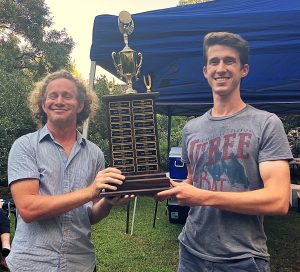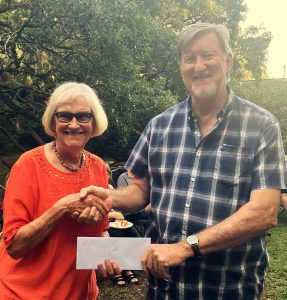In 2022 a late afternoon thunderstorm gave us a good soaking and in 2023 an entire morning of bluster and squalls dampened our spirits. This year, the 2024 John Hintermister Gainesville Christmas Bird Count had dry skies, mild temperatures, and happy birders. The birds themselves put on quite the show this year: we tied our all-time high record of 175 species! And, for the first time, we topped 100,000 individuals, with 106,204 birds tallied! We should maintain our solid positions as one of the highest inland counts in the United States, and as tops for species number in Florida. Our intrepid observers were dispersed among eleven teams, each with a team captain. As we ran through the tallies of the regularly occurring species at the compilation on Sunday evening, anticipation mounted with each addition (see below) and with each species missed (Horned Grebe, American Pipit, Wil son’s Warbler, Field Sparrow, and Indigo Bunting). Excitement peaked as each team captain read the rare species found in their sector on count day. Three new species were recorded for the first time on this CBC: a Bell’s Vireo on the edge of Payne’s Prairie (Team 1), a Cape May Warbler visiting a suburban feeder in NE Gainesville (Team 10), and a pair of Red-throated Loons on Newnan’s Lake (Team 11). The day’s rarities were nicely distributed in all sectors and included: Team 1: Fulvous Whistling-Duck, Cinnamon Teal, 3 Gray-headed Swamphen, Least Flycatcher, Ash-throated Flycatcher, Bell’s Vireo; Team 2: Common Goldeneye, Ash-throated Flycatcher; Team 3: Yellow-crowned Night Heron, 5 Golden-crowned Kinglets, Brown Creeper, Winter Wren, 2 Bachman’s Sparrow, Team 4: Red-breasted Merganser, Barn Swallow; Team 5: Ash-throated Flycatcher; Team 6 5 Golden crowned Kinglets Tropical Kingbird, Team 7: Ash-throated Flycatcher, Black-throated Green Warbler, Lincoln’s Sparrow, Team 8 Magnolia Warbler (had only been seen once before in 1990); Team 9: Western Tanager, Team 10: Golden-crowned Kinglet, Cape May Warbler, Bachman’s Sparrow; Team 11: Red-throated Loon. With those last additions, and a final perusal of documentation, we had reached our previous record, set in 2019. The bread and butter of a Christmas Bird Count, however, is determining the population status of the area’s more common species, which can aid in determining conservation planning for our mostly declining avifauna. For our 2024 count, our 120 + observers reached new all-time high counts for 16 species: Northern Pintail, American Bittern, Northern Harrier, Barred Owl, Eastern Phoebe, Vermilion Flycatcher, Carolina Chickadee, Tufted Titmouse, Gray Catbird, House Wren, American Robin, House Finch, Black & White Warbler, Orange crowned Warbler, Yellow-breasted Chat, Swamp Sparrow. Especially notable were numbers of fruit eaters like American Robin (42,692!), Gray Catbird, and Cedar Waxwing. The numbers of flocking woodland species were also high, with records for Tufted Titmouse, Carolina Chickadee, Black-and-white Warbler, and Orange-crowned Warbler. Thankfully, Alachua County, with its expansive network of protected areas, woods, lakes, and prairies, continues to harbor important wintering populations of a wide assortment of bird species. Species list (bold-faced species = rarity; bold-faced count = high count): Black-bellied Whistling-Duck 4213, Fulvous Whistling-Duck 1, Snow Goose 5, Muscovy Duck 206, Wood Duck 229, Gadwall 33, American Wigeon 7, Mallard 10, Mottled Duck 283, Blue-winged Teal 1056, Cinnamon Teal 1, Northern Shoveler 24, Northern Pintail 985 (HC), Green-winged Teal 2890, Redhead 1, Ring-necked Duck 9863, Lesser Scaup 85, Common Goldeneye 1, Bufflehead 27, Red-breasted Merganser 3, Hooded Merganser 220, Ruddy Duck 76, Northern Bobwhite 24, Wild Turkey 125, Pied-billed Grebe 60, Rock Pigeon 24, Eurasian Collared Dove 2, Common Ground-Dove 17, Mourning Dove 491, White-winged Dove 1, Whip-Poor-Will 6, Ruby-throated Hummingbird 5, Rufous Hummingbird 1, King Rail 14, Virginia Rail 35, Sora 124, Purple Galli nule 4, Gray-headed Swamphen 3, Common Gallinule 577, American Coot 619, Limpkin 168, Sandhill Crane Page 11 The Crane Alachua Audubon Society Volume 66 Number 3 Jan – Feb 2025 1842, Killdeer 242, Least Sandpiper 31, Wilson’s Snipe 220, Long-billed Dowitcher 3, American Woodcock 6, Spotted Sandpiper 2, Greater Yellowlegs 27, Lesser Yellowlegs 12, Bonaparte’s Gull 8, Laughing Gull 18, Ring billed Gull 259, Herring Gull 2, Forster’s Tern 31, Common Loon 8, Red Throated Loon 2, Wood Stork 133, Double-crested Cormorant 788, Anhinga 409, American White Pelican 130, American Bittern 33 (HC), Least Bit tern 27, Great Blue Heron 227, Great Egret 262, Snowy Egret 177, Little Blue Heron 234, Tricolored Heron 102, Cattle Egret 309, Green Heron 38, Black-crowned Night-Heron 217, Yellow-crowned Night-Heron 1, White Ibis 2271, Glossy Ibis 419, Roseate Spoonbill 6, Black Vulture 451, Turkey Vulture 1399, Osprey 25, Snail Kite 112, Bald Eagle 143, Northern Harrier 111 (HC), Sharp-shinned Hawk 7, Cooper’s Hawk 17, Accipiter, sp. 2, Red shouldered Hawk 235, Red-tailed Hawk 40, Barn Owl 6, Eastern Screech-Owl 24, Great Horned Owl 42, Barred Owl 81 (HC), Belted Kingfisher 61, Red-headed Woodpecker 32, Red-bellied Woodpecker 526, Yellow-bellied Sap sucker 101, Downy Woodpecker 234, Northern Flicker 67, Pileated Woodpecker 179, American Kestrel 73, Merlin 3, Peregrine Falcon 1, Eastern Phoebe 602 (HC), Vermilion Flycatcher 7 (HC), Least Flycatcher 1, Tropical Kingbird 1, Ash-throated Flycatcher 5, Loggerhead Shrike 33, White-eyed Vireo 75, Blue-headed Vireo 82, Bell’s Vireo 1, Blue Jay 240, American Crow 813, Fish Crow 131, Crow, sp. 67, Tree Swallow 698, Barn Swallow 1, Carolina Chickadee 582 (HC), Tufted Titmouse 686 (HC), Brown-headed Nuthatch 22, Brown Creeper 1, House Wren 331 (HC), Winter Wren 1, Sedge Wren 117, Marsh Wren 54, Carolina Wren 595, Blue-gray Gnatcatcher 548, Ruby-crowned Kinglet 728, Golden crowned Kinglet 11, Eastern Bluebird 325, Hermit Thrush 65, American Robin 42692 (HC), Gray Catbird 384 (HC), Brown Thrasher 23, North ern Mockingbird 194, European Starling 15, Cedar Waxwing 2038, House Sparrow 31, House Finch 173 (HC), American Goldfinch 333, Ovenbird 9, Northern Waterthrush 12, Black-and-White Warbler 175 (HC), Orange-crowned Warbler 182 (HC), Common Yellowthroat 326, American Red start 3, Northern Parula 4, Magnolia Warbler 1, Cape May Warbler 1, Palm Warbler 1197, Pine Warbler 221, Yel low-rumped Warbler 2364, Yellow throated Warbler 57, Black-throated Green Warbler 1, Prairie Warbler 3, Yellow-breasted Chat 5 (HC), Eastern Towhee 69, Chipping Sparrow 834, Vesper Sparrow 8, Savannah Sparrow 204, Grasshopper Sparrow 12, Hens low’s Sparrow 4, Bachman’s Sparrow 3, Song Sparrow 43, Lincoln’s Spar row 1, Swamp Sparrow 610 (HC), White-throated Sparrow 28, White crowned Sparrow 3, Summer Tanager 3, Western Tanager 1, Northern Cardinal 726, Painted Bunting 25, Red winged Blackbird 7517, Eastern Meadowlark 84, Rusty Blackbird 125, Common Grackle 1382, Boat-tailed Grackle 1872, Brown-headed Cowbird 351, Baltimore Oriole 42.
By Andy Kratter

